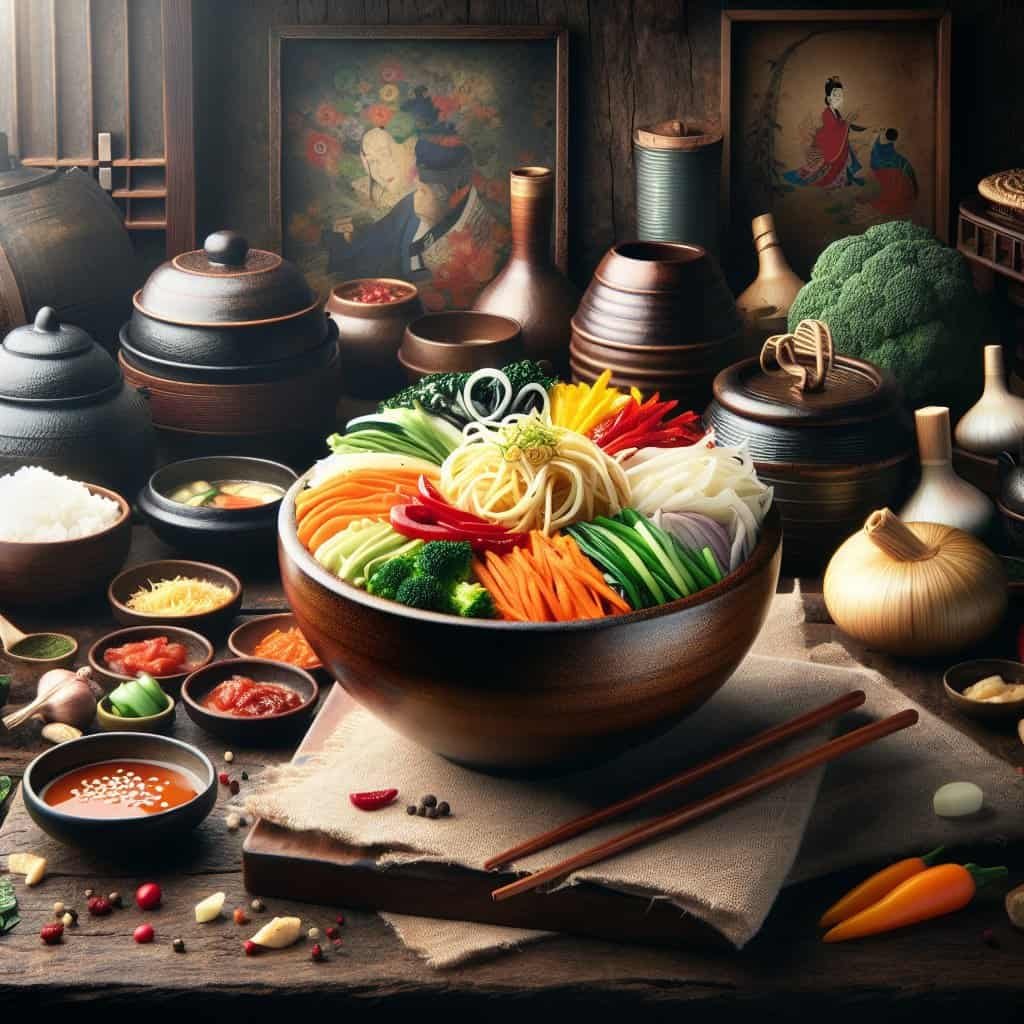Imagine being transported back in time to your grandmother’s kitchen, where the tantalizing scents of traditional Korean cuisine waft through the air. These dishes, steeped in history and treasured for generations, evoke a sense of nostalgia and timelessness. From the comforting warmth of bibimbap to the hearty flavors of kimchi jjigae, Korean cuisine is a cultural treasure trove of dishes that have stood the test of time. Today, we invite you to embark on a culinary journey as we explore the beloved Korean dishes that tug at heartstrings and carry the essence of tradition.
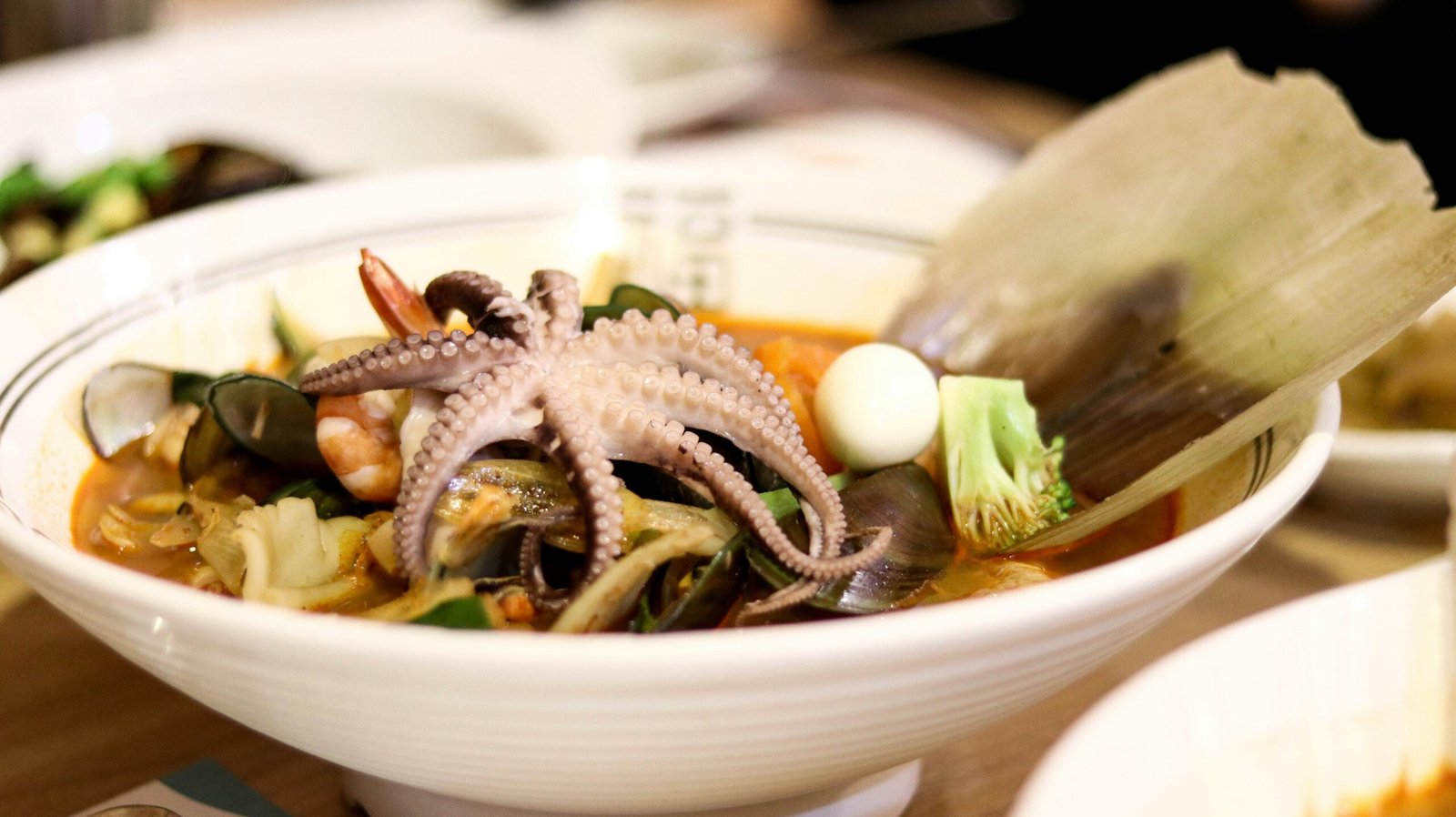
Traditional Korean Dishes
Korean cuisine is known for its flavorful and distinct dishes that have been enjoyed for generations. From hearty stews to mouthwatering street foods, there is something for everyone to enjoy. Let’s explore some of the traditional Korean dishes that are considered nostalgic and timeless.
Bibimbap
One of the most iconic Korean dishes, Bibimbap is a colorful and nutritious rice bowl that is loved by locals and visitors alike. The dish consists of steamed rice topped with an assortment of sautéed vegetables, marinated meat (usually beef), a fried egg, and a dollop of spicy gochujang sauce. The ingredients are mixed together before being consumed, creating a harmonious blend of flavors and textures. Bibimbap is not only delicious but also visually appealing, making it a feast for both the eyes and the taste buds.
Kimchi
When talking about Korean cuisine, it is impossible to overlook Kimchi. This fermented cabbage dish has been a staple in Korean homes for centuries and is considered the national dish of Korea. Kimchi is made by fermenting cabbage, radishes, and other vegetables with a combination of spices, such as red chili pepper flakes, garlic, ginger, and salted seafood. The result is a tangy and spicy side dish that is often enjoyed with every meal. The process of making and eating kimchi has become deeply ingrained in Korean culture and is a symbol of tradition and heritage.
Bulgogi
Another classic Korean dish that is sure to evoke nostalgia is Bulgogi. This thinly sliced beef is marinated in a sweet and savory sauce made from soy sauce, sugar, garlic, and sesame oil before being grilled or stir-fried. The result is tender and flavorful meat that pairs perfectly with rice and a variety of side dishes. Bulgogi is often enjoyed at special occasions and celebrations, bringing families and friends together to savor this beloved heritage dish.
Japchae
Japchae is a traditional Korean stir-fried noodle dish that is both nostalgic and timeless. Made with sweet potato glass noodles, various vegetables, and marinated beef, Japchae features a combination of flavors and textures that make it a favorite among Koreans. The dish is typically seasoned with soy sauce, sesame oil, and sugar, giving it a balanced and slightly sweet taste. Japchae is often served at celebratory events and family gatherings, making it a dish that holds many cherished memories for Koreans.
Comforting Soups and Stews
Korean cuisine is also known for its comforting soups and stews that warm the soul. These dishes have a long history and are often enjoyed during colder months or when seeking solace in a bowl of deliciousness.
Samgyetang
Samgyetang is a traditional Korean chicken soup that is believed to have various health benefits. It is made by simmering a whole chicken stuffed with glutinous rice, garlic, jujubes, and ginseng in a flavorful broth for hours. The result is a rich and nourishing soup that is believed to boost energy and vitality. Samgyetang is typically enjoyed during the hot summer months to combat fatigue and strengthen the body. It is a dish that brings comfort and warmth to both the body and soul.
Doenjang-jjigae
Doenjang-jjigae is a hearty and savory soybean paste stew that is a staple in Korean households. Made with fermented soybean paste, tofu, vegetables, and often seafood or meat, this dish boasts complex flavors and a rich umami taste. Doenjang-jjigae is often enjoyed with a bowl of steamed rice, creating a satisfying and comforting meal. It is a dish that brings back memories of home-cooked meals and family gatherings around the dinner table.
Sundubu-jjigae
If you’re seeking a spicy and indulgent soup, look no further than Sundubu-jjigae. This spicy soft tofu stew is made with silky soft tofu, vegetables, and often seafood or meat, all simmered in a spicy broth flavored with gochujang (red chili pepper paste) and gochugaru (red chili pepper flakes). The combination of soft tofu and fiery spices create a unique and delightful taste that is sure to warm your soul. Sundubu-jjigae is often enjoyed as a comforting meal during cold winter days, offering a delicious escape from the chilly weather.
Galbitang
Galbitang is a clear and soothing beef short rib soup that is considered a delicacy in Korean cuisine. Made with beef short ribs, radish, onions, garlic, and various aromatic herbs and spices, Galbitang is simmered for hours, resulting in a flavorful and tender meat. The clear broth is light and refreshing, making it a perfect choice for those seeking a lighter option. Galbitang is often enjoyed with a bowl of rice and a side of kimchi, creating a balanced and satisfying meal that is both comforting and satisfying.

Classic Street Foods
Korean street foods are renowned for their taste, convenience, and affordability. These dishes have been enjoyed by generations and continue to be a beloved part of Korean culinary culture.
Tteokbokki
One of the most popular street foods in Korea, Tteokbokki is a spicy rice cake dish that is sure to leave you craving for more. Tteokbokki is made with chewy rice cakes stir-fried in a spicy gochujang-based sauce, which gives it its signature heat and flavor. It is often served with fish cakes, boiled eggs, and scallions, creating a delicious and satisfying snack or meal. Tteokbokki is a must-try street food for those looking to experience the vibrant and bold flavors of Korean cuisine.
Jajangmyeon
Jajangmyeon is a popular Korean-Chinese noodle dish that has become a staple in Korean street food culture. This dish features thick and chewy noodles topped with a rich and savory black bean sauce, stir-fried with various vegetables and often diced pork. Jajangmyeon is known for its deep and robust flavors, making it a favorite comfort food for many Koreans. It is commonly enjoyed as a quick and satisfying meal, perfect for those on the go or looking for a tasty late-night snack.
Gimbap
Similar to sushi, Gimbap is a Korean rice and seaweed roll that is filled with a variety of ingredients. These rolls are typically made with seasoned rice, pickled radish, carrots, spinach, and various other fillings, such as egg, ham, or fish cakes. Gimbap is a versatile street food that can be enjoyed as a light meal or a snack. The combination of flavors and textures make it a popular choice for picnics, lunchboxes, or a quick bite to eat. Gimbap is a timeless dish that brings back memories of childhood and family outings.
Hotteok
When it comes to sweet treats, Hotteok is a beloved Korean street food that never fails to satisfy. Hotteok is a sweet pancake filled with a gooey mixture of brown sugar, cinnamon, and chopped nuts. The pancake is then fried until it turns golden brown and crispy on the outside, while the filling becomes warm and melty on the inside. Hotteok is a comforting and indulgent treat that is often enjoyed during winter months or as a special treat on a chilly day. Its sweet aroma and delicious taste make it a favorite among Koreans of all ages.
Delicious Snacks and Side Dishes
Korean cuisine offers a wide range of snacks and side dishes that are packed with flavor and can be enjoyed on their own or as accompaniments to main meals. These dishes are perfect for sharing with friends or as a light and tasty snack.
Pajeon
Pajeon is a savory pancake that is packed with an array of ingredients, such as scallions, seafood, and sometimes kimchi. The pancake batter is made with flour, eggs, and water, resulting in a crispy and flavorful pancake that is best enjoyed when dipped in a soy-based dipping sauce. Pajeon is often enjoyed as a snack or appetizer, and it is a popular choice for social gatherings or outings with friends. Its versatility and delicious taste make it a timeless and beloved dish in Korean cuisine.
Kimbap
Similar to sushi rolls, Kimbap is a popular Korean rice roll that is filled with a variety of ingredients. The rolls are typically made with seasoned rice, vegetables, and often meat or seafood. Kimbap is then tightly wrapped in seaweed and cut into bite-sized pieces. It is a convenient and tasty snack that can be enjoyed on the go or as a light meal. Kimbap is often seen as a nostalgic and timeless dish, reminiscent of childhood picnics or school lunches.
Mandu
Mandu, also known as Korean dumplings, are a delicious and versatile snack or side dish. Mandu can be filled with a variety of ingredients, such as pork, beef, vegetables, or kimchi, and they can be steamed, boiled, or pan-fried. The dumplings are typically served with a soy-based dipping sauce, and they are enjoyed by people of all ages. Mandu is a popular dish during special occasions, such as Lunar New Year or family gatherings, and it holds a special place in the hearts of Koreans as a symbol of warmth and togetherness.
Korean Fried Chicken
Korean Fried Chicken, often referred to as KFC, is a crispy and flavorful dish that has gained immense popularity worldwide. Korean fried chicken is known for its thin and crunchy skin, as well as its tender and juicy meat. The chicken is typically double-fried to achieve the perfect texture, and it is then coated in a variety of sauces, such as spicy gochujang or sweet soy garlic. Korean fried chicken is a favorite snack or meal for many Koreans, and it is often enjoyed with a side of pickled radish and a cold beer. Its addictive flavors and satisfying crunch make it a timeless and beloved dish.
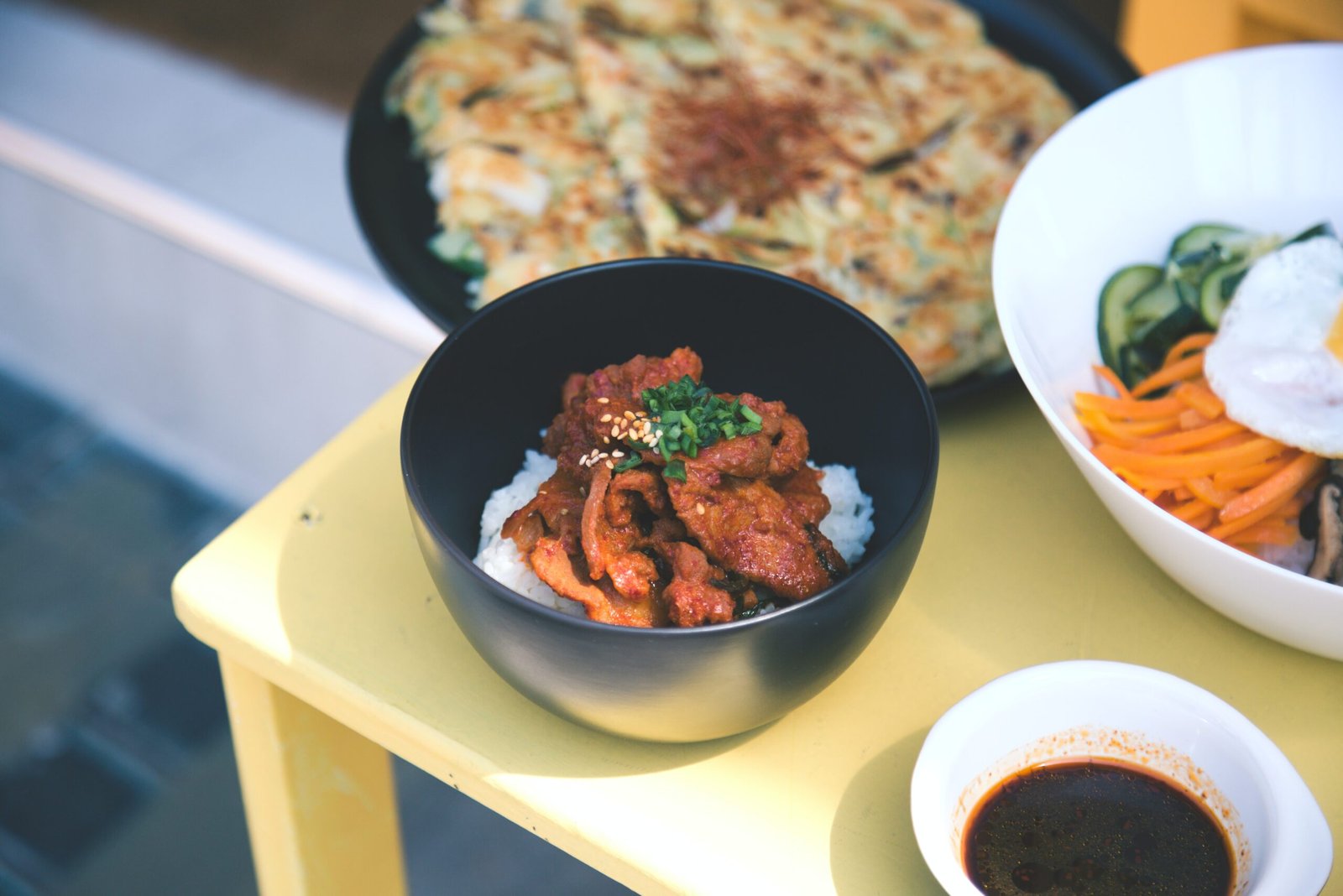
Celebration and Festive Dishes
Korean cuisine is closely tied to celebrations and festive events. These dishes are enjoyed during special occasions or holidays and are considered a symbol of happiness and togetherness.
Japchae
Although we have already mentioned Japchae as a nostalgic dish, it is also commonly enjoyed during celebrations and festive gatherings. Japchae is often served at weddings, birthdays, or holidays, symbolizing good fortune, longevity, and prosperity. Its vibrant colors and delicious flavors make it a staple dish on any celebratory table.
Jeon
Jeon refers to a variety of savory pancakes or fritters that are commonly served during festive occasions. Jeon can be made with a wide range of ingredients, such as seafood, vegetables, or meat, and they are typically battered and pan-fried to perfection. Jeon is a versatile dish that can be enjoyed as an appetizer, side dish, or a main meal. It is often accompanied by a dipping sauce and is a popular choice during Lunar New Year celebrations or family gatherings.
Yakgwa
Yakgwa is a traditional Korean sweet pastry that is often enjoyed during holidays and special occasions. These bite-sized treats are made with a combination of honey, sesame oil, and wheat flour, resulting in a soft and chewy texture. Yakgwa is often shaped into intricate designs, such as flower shapes or braids, making it a visually stunning dessert. These delicate pastries are a symbol of good luck and are often shared and enjoyed with loved ones.
Songpyeon
Songpyeon is a traditional Korean rice cake that is a must-have dish during the harvest festival, known as Chuseok. Songpyeon is made with a mixture of glutinous rice flour and water, which is shaped into small balls and filled with various sweet or savory fillings. The rice cakes are then steamed on a bed of pine needles, imparting a subtle aroma and flavor. Songpyeon is a symbol of gratitude and respect for ancestors and is often shared among family members during the Chuseok holiday.
Old-Fashioned Desserts
Korean cuisine offers a variety of old-fashioned desserts that have been enjoyed for generations. These sweet treats often bring back memories of childhood and simpler times.
Patbingsu
Patbingsu is a popular Korean shaved ice dessert that is enjoyed during the hot summer months. This refreshing treat consists of a mound of shaved ice topped with various ingredients, such as sweet red beans, fruits, condensed milk, and sometimes ice cream. Patbingsu is a delightful and cooling dessert that is perfect for beating the summer heat. It is often enjoyed with friends or family, creating memories of laughter and shared enjoyment.
Hoddeok
Hoddeok is a delicious and indulgent pancake filled with a sweet mixture of brown sugar, cinnamon, and chopped nuts. The pancake is then fried until it turns golden brown and crispy on the outside, while the filling becomes warm and melty on the inside. Hoddeok is enjoyed during the winter months as a comforting and warming treat. The aroma of the cinnamon and the sweetness of the filling make it a nostalgic and irresistible dessert.
Sujeonggwa
Sujeonggwa is a traditional Korean punch made from dried persimmons, cinnamon, ginger, and sugar. This punch is simmered for hours to infuse all the flavors together, resulting in a sweet and aromatic beverage. Sujeonggwa is often enjoyed during the festive season and is believed to aid digestion and bring good luck. The beautiful reddish-brown color and the delicate scent of spices make it a cherished and timeless dessert.
Yakwa
Yakwa is a traditional Korean honey pastry that has been enjoyed since ancient times. These diamond-shaped pastries are made from a mixture of wheat flour, honey, and sesame oil, resulting in a chewy yet delicate texture. Yakwa is often enjoyed during holidays and special occasions, such as Lunar New Year or weddings. The combination of flavors and the intricate patterns on the pastries make them a beloved symbol of tradition and celebration.
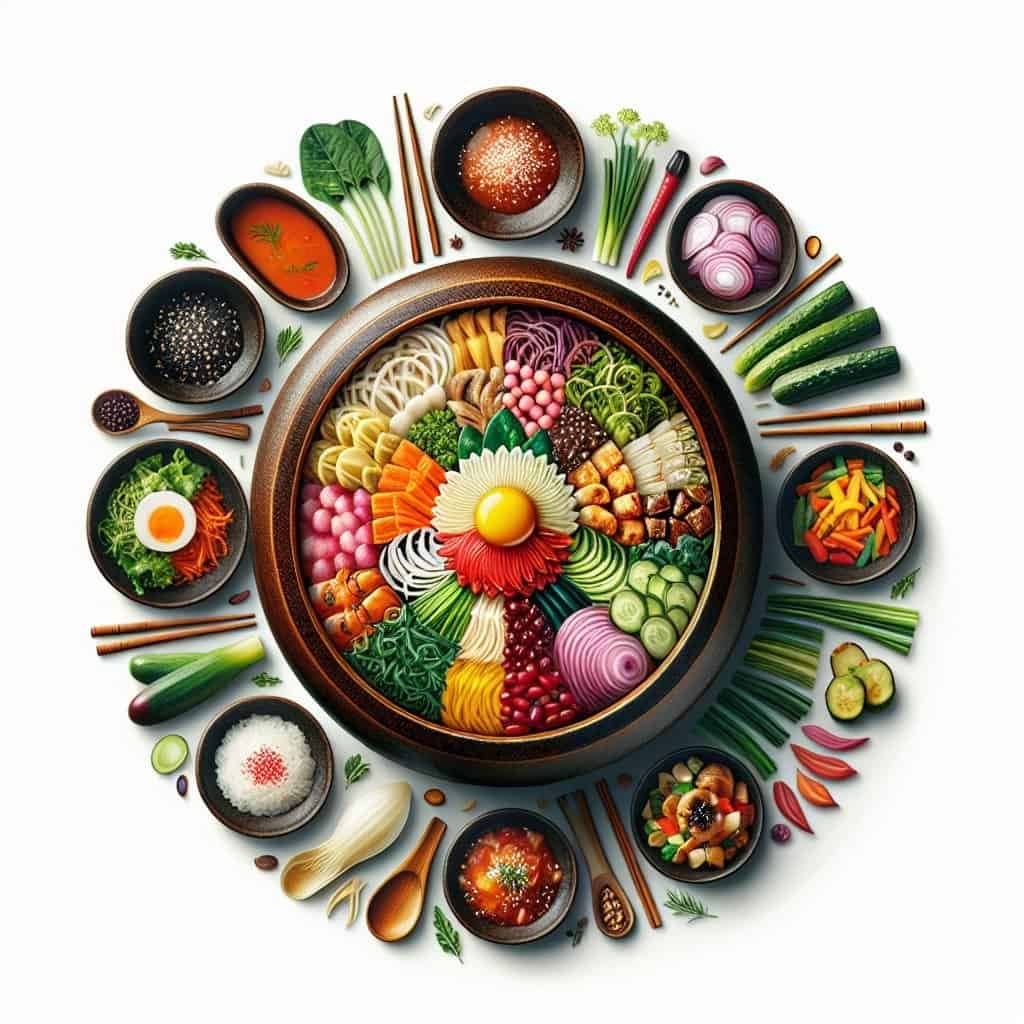
Homemade Comfort Food
Sometimes, the most comforting and delicious meals come from the heart and the warmth of home cooking. These homemade dishes hold a special place in the hearts of Koreans and are often enjoyed during cozy family meals or when seeking solace in the familiarity of their flavors.
Budae-jjigae
Budae-jjigae, also known as Army Stew, is a hearty and comforting stew that originated during the Korean War. The stew is made with a combination of ingredients, such as spam, sausages, canned baked beans, kimchi, instant noodles, and tofu, all cooked together in a spicy broth. Budae-jjigae is a symbol of resilience and resourcefulness in times of hardship. It is a dish that brings people together and provides warmth and comfort in difficult times.
Kongbiji-jjigae
Kongbiji-jjigae is a creamy and flavorful stew made from ground soybeans. The stew is often cooked with various vegetables, tofu, and sometimes pork or seafood, resulting in a rich and comforting dish. Kongbiji-jjigae is known for its velvety texture and mellow taste, making it a popular choice for those seeking a mild yet satisfying meal. It is often enjoyed during cold winter days, providing warmth and nourishment to the body and soul.
Bokkeumbap
Bokkeumbap is a Korean stir-fried rice dish that is perfect for using up leftover ingredients. The dish typically consists of cooked rice stir-fried with an assortment of vegetables, meat, and sometimes kimchi or eggs. The combination of flavors and textures make bokkeumbap a versatile and delicious dish that can be customized to suit personal preferences. It is often enjoyed as a quick and easy meal that brings back memories of home cooking and the love that goes into preparing a homemade meal.
Gamjatang
Gamjatang is a hearty and spicy potato and pork bone soup that is a favorite among Koreans. This stew is made by simmering pork bones, potatoes, vegetables, and spices for hours, resulting in a rich and flavorful broth. Gamjatang is often enjoyed with a bowl of rice and a side of kimchi, creating a satisfying and comforting meal. It is a dish that warms the body and nourishes the soul, reminding Koreans of the warmth and love that can only come from homemade cooking.
Nostalgic Childhood Treats
Childhood treats hold a special place in our hearts and bring back fond memories of carefree days. These nostalgic Korean treats continue to be enjoyed by people of all ages.
Bungeoppang
Bungeoppang is a popular Korean fish-shaped pastry that is often enjoyed during winter months. This crispy and sweet treat is made by pouring a sweet pancake batter into a fish-shaped mold and then filling it with a sweet red bean paste. Bungeoppang is typically enjoyed while it is still warm, with the filling melting in your mouth. The combination of the crispy exterior and the sweet bean paste creates a delightful contrast of textures and flavors that is reminiscent of childhood fairs and festivals.
Sundae
Sundae is a popular Korean blood sausage that is enjoyed both as a street food and as a side dish. Sundae is made by stuffing pig intestines with a mixture of glass noodles, pork blood, and various seasonings. The sausage is then steamed or boiled and served with a spicy dipping sauce. Sundae is a unique and flavorful treat that is enjoyed by many Koreans, especially during festive occasions or as a comforting snack.
Hoppang
Hoppang is a steamed bun filled with a savory or sweet filling. These fluffy buns are made with a dough that is filled with ingredients such as vegetables, meat, or red bean paste. Hoppang is often enjoyed during colder months as a warming and satisfying snack. Its soft texture and comforting flavors make it a beloved treat that reminds Koreans of cozy winter days and childhood memories.
Hotteok
Already mentioned as a classic street food, Hotteok also carries a strong nostalgic factor for many Koreans. These sweet pancakes filled with brown sugar, cinnamon, and chopped nuts bring back memories of the neighborhood vendors and the joy of indulging in a warm and sweet treat. Hotteok is a timeless and nostalgic dessert that is enjoyed by people of all ages, reminding them of simpler times and the simple pleasures of childhood.
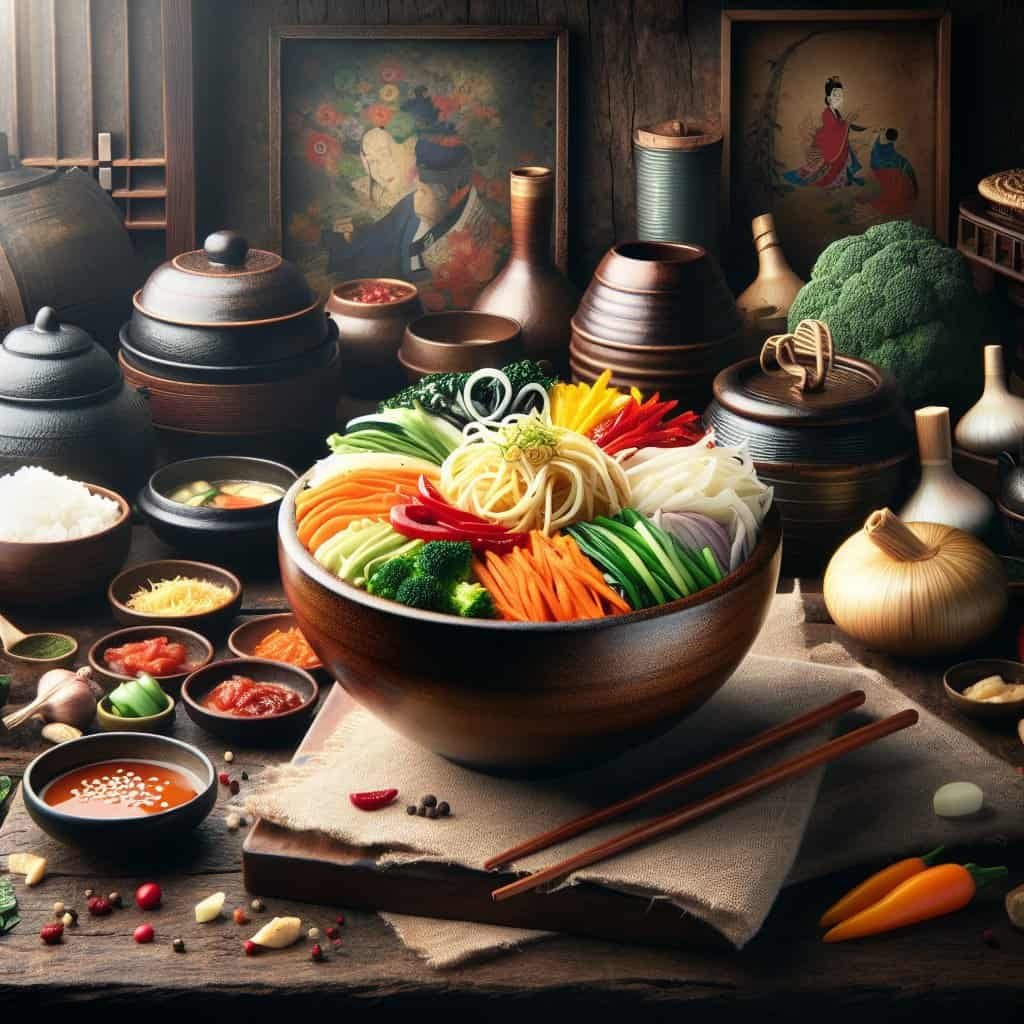
Celebratory Rice Dishes
Rice is a staple in Korean cuisine, and there are various rice dishes that are enjoyed during celebratory events. These dishes symbolize abundance, prosperity, and joy.
Bibimbap
Although we have already featured Bibimbap as a traditional Korean dish, it is also commonly enjoyed during celebratory events. Bibimbap is often served at weddings or special occasions, symbolizing a wish for prosperity and a harmonious union. Its vibrant colors and wholesome ingredients make it a visually stunning and delicious dish that is sure to add joy to any celebration.
Ssambap
Ssambap is a celebratory dish that involves wrapping rice and various fillings in lettuce or other leafy greens. The dish is often enjoyed during special occasions or family gatherings, where it is shared among loved ones. Ssambap is a versatile dish that allows for personal customization and encourages social interaction as everyone gathers around to create their own unique wraps. The act of making and sharing ssambap is a celebration of togetherness and love.
Gungjung-tteokbap
Gungjung-tteokbap is a royal rice dish that originated during the Joseon Dynasty. The dish is made with rice cooked with a combination of vegetables, meat, and various seasonings, resulting in a flavorful and satisfying meal. Gungjung-tteokbap is often enjoyed during special occasions or ceremonial events, symbolizing prosperity and nobility. It is a dish that transports Koreans back to a time of opulence and grandeur.
Japgokbap
Japgokbap is a celebratory dish made with a combination of rice and various grains, such as beans, barley, and millet. The dish is often enjoyed during holidays or special occasions, symbolizing abundance and good fortune. Japgokbap is cooked together with vegetables, meat, and various seasonings, creating a flavorful and wholesome meal. It is a dish that represents the bountiful harvest and the unity of family and community.
Iconic Traditional Drinks
To complement the rich flavors of Korean cuisine, there are several traditional drinks that have gained iconic status in Korean culture. These beverages, often enjoyed during festive events or as accompaniments to meals, enhance the overall dining experience.
Makgeolli
Makgeolli is a traditional Korean rice wine that has been enjoyed for centuries. This milky and slightly sweet alcoholic beverage is made from fermented rice, water, and nuruk (a fermentation starter). Makgeolli has a low alcohol content and a mild flavor, making it a popular choice for those who prefer a lighter drink. It is often enjoyed during festivals, celebrations, or as a refreshing accompaniment to Korean dishes. Makgeolli brings a touch of joy and festivity to any gathering.
Sikhye
Sikhye is a sweet and refreshing traditional Korean rice beverage that is enjoyed throughout the year. It is made by fermenting cooked rice with malted barley and then adding sugar and sometimes pine nuts or dried fruits for added flavor. Sikhye is typically served cold and is often enjoyed as a dessert or a palate cleanser after a meal. Its delicate sweetness and unique texture make it a beloved and timeless drink in Korean culture.
Sujeonggwa
Already mentioned as an old-fashioned dessert, Sujeonggwa also holds a prominent place among traditional Korean drinks. This punch made from dried persimmons, cinnamon, and ginger is not only a dessert but also a popular beverage during festive occasions. Sujeonggwa is known for its rich flavors and warming properties, making it a perfect choice during cold winter months. Its vibrant color and aromatic scent create a joyful and festive atmosphere.
Cheongju
Cheongju is a clear and refined rice wine that is often enjoyed during special occasions or as part of traditional ceremonies. This wine is made by fermenting rice with nuruk and then removing the sediment to obtain a clear liquid. Cheongju has a mild and delicate flavor, with subtle floral and fruity notes. It is often served chilled and is enjoyed as a toast or a celebratory drink. Cheongju is a symbol of elegance and sophistication that adds an air of refinement to any occasion.
In Conclusion,
Korean cuisine offers a diverse range of dishes that are deeply rooted in tradition and cherished as timeless classics. From flavorful rice bowls to comforting soups, vibrant street foods, and delightful snacks and desserts, there is something for everyone to enjoy. Whether you are seeking a taste of nostalgia or looking to explore new flavors, the traditional Korean dishes mentioned in this article are sure to satisfy your cravings and leave you wanting more. So, grab a friend or loved one, embark on a culinary adventure, and experience the rich and vibrant flavors of Korean cuisine.
